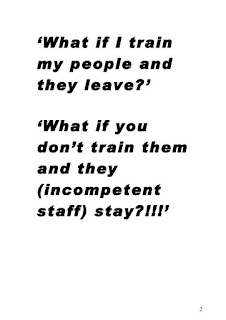If you listen to friends and social media then you hear a lot about unsatisfied customers. People that are supposed to be a returning customer that wows that they will never go to the such and such restaurant ever again. As an Example – I found this complaint on Trip Advisor! You don’t want your restaurant to be next!
Do you have any plans to train your waiters to get the orders right and to clear plates away after the main course before serving desserts? Do you also intend to train the staff not to ignore customers? Finally, do you intend to train your managers on how to deal with valid complaints without threatening to call the police?
For a little bit of fun – watch this video – I’m sure all of us have seen a bad waiter at some time…
So why do you need to do regular waiter training?
According to www.webrestaurantstore.com - Regardless of a restaurant's size or style, the serving staff represents the face of every dining establishment. These individuals will interact the most with your customers during a visit, and positive interactions can go a long way towards ensuring those same patrons return. Hiring the right employees for the job from the start is always ideal, but the introduction of a structured server training program can pay huge dividends for your business. The following guidelines for restaurant server training will help establish an effective, knowledgeable staff and should remain as focal teaching points for all employees.
1. Etiquette
These days, restaurant servers are required to perform more than just "service with a smile." While it may be difficult to "teach" the best social skills, your servers should nonetheless be encouraged to make customers feel welcome. Guests are looking for a wait staff with a positive attitude, cheery disposition, and willingness to accommodate any request from the start of the meal to the very end.
2. Appearance
A sloppy uniform can serve as a red flag for any number of new guests.
3. Knowledge of Menu
Just as important as appearance and etiquette are a working knowledge of the restaurant and its food offerings.
4. Knowledge of Restaurant Layout
During waiter or waitress training, be sure to identify key routes to the most important parts of the facility.
5. Knowledge of Restaurant Vision
Your restaurant concept and history are important, and will typically remain a large part of day-to-day operations. Make sure your employees recognize this and can speak to the restaurant's background, notable characteristics, or even historical accomplishments
6. Ongoing Training
Several of these guidelines, such as your restaurant layout and the menu, may change over time, so it's important to use all of these teaching points as part of ongoing training sessions for all your servers. By implementing an ongoing training program, you have the opportunity to increase productivity, update policies to comply with new industry regulations, and improve job satisfaction in a work area that's often high in employee turnover. Some specific things to make part of long-term training include:
· Learning which menu items are most popular, least expensive, most expensive, etc.
· Acquiring knowledge of weekly or daily specials
· Successfully selling guests on appetizers or desserts
· Finding the right balance between too much and too little interaction with guests at their table
· Improving awareness and multi-tasking skills
· Reading personalities/attitudes and determining exactly which kind of service the guest desires
Single-event training can often be forgotten or seem overwhelming for a new employee on the first day. Ongoing training allows for employers to evaluate and follow-up effectively in order to get the most out of their staff. This type of restaurant server training can help propel your operation to the next level of professional, award-winning service.

























